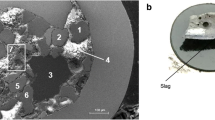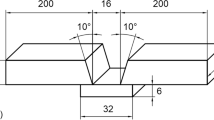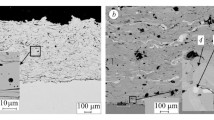The use of exothermic addition (EA) for charge in flux-cored wire is a promising way to improve technological characteristics of welded joints. The mathematical models to determine the charge density and the fill factor, which depend on the EA content, the ratio of graphite to EA oxidizer (CuO/C) and the ratio of the oxidizer to the aluminum powder in the composition of the EA (CuO/Al) were built. The investigated fusion modes depend mostly on such parameters: EA = 26–28 mass%, CuO/C = 4.0–4.5 and CuO/Al = 4.50–5.25.


Similar content being viewed by others
References
M. M. Student, H. V. Pokhmurs’ka, and K. R. Zadorozhna, “Structure and wear resistance of VC–FeCr and VC–FeCrCo coatings obtained by supersonic flame spraying,” Mater. Sci., 54, No. 1, 22–29 (2018); https://doi.org/10.1007/s11003-018-0152-9.
E. Kocaman, B. Kılınç, Ş. Şen, and U. Şen, “Development of surface properties with in situ TiB2 intermetallic-assisted coating by Fe(18-X)Ti2BX (x = 3,4,5)-based electrodes,” Arabian J. for Sci. and Eng., 47, Is. 7, art. no. 84858501 (2022); https://doi.org/10.1007/s13369-021-06304-0.
M. M. Student, V. M. Posuvailo, H. H. Veselivs’ka, Ya. Ya. Sirak, and R. A. Yatsyuk, “Corrosion resistance of plasma-electrolytic layers on alloys and coatings of the Al–Cu–Mg system for various modes of heat treatment,” Mater. Sci., 53, No. 6, 789–795 (2018); https://doi.org/10.1007/s11003-018-0137-8.
B. O. Trembach, M. G. Sukov, V. A. Vynar, I. O. Trembach, V. V. Subbotina, O. Yu. Rebrov, O. M. Rebrova, and V. I. Zakiev, “Effect of incomplete replacement of Cr for Cu in the deposited alloy of Fe–C–Cr–B–Ti alloying system with a medium boron content (0.5 wt%) on its corrosion resistance,” Metallofizika i Noveishie Tekhnologii, 44, Is. 4, 493–513 (2022); https://doi.org/10.15407/mfint.44.04.0493.
O. V. Sukhova, “The effect of carbon content and cooling rate on the structure of Boron-rich Fe-B-C alloys,” Physics and Chemistry of Solid State, 21, Is. 2, 355–360 (2020); https://doi.org/10.15330/PCSS.21.2.355-360.
W. Sawczuk, A. Merkisz-Guranowska, D. Ulbrich, J. Kowalczyk, A.-M. R. Cañás, “Investigation and modelling of the weight wear of friction pads of a railway disc brake,” Materials, 15, Is. 18, art. no. 6312 (2022); https://doi.org/10.3390/ma15186312.
D. Ulbrich, A. Stachowiak, J. Kowalczyk, D. Wieczorek, and W. Matysiak, “Tribocorrosion and abrasive wear test of 22MnCrB5 hot-formed steel,” Materials, 15, Is. 11, art. no. 3892 (2022); https://doi.org/10.3390/ma15113892.
B. Güney, and Y. Dilay, “Determination of abrasion resistance of Fe28Cr5C1Mn coating applied to 30MnB5 boron alloy cultivator blades via electric arc spray,” in: Proc. of the Institution of Mech. Eng., Part C: J. of Mech. Eng. Sci., 236, Is. 17, art. no. 96879699 (2022); https://doi.org/10.1177/09544062221097803.
M. Ushio, A. Raja, and F. Matsuda, “Melting characteristics of flux cored wire (welding physics, process & instrument),” Transactions of JWRI, 13, Is. 1, 1–6 (1984); https://doi.org/10.18910/4482.
E. Yamamoto, K. Yamazaki, K. Suzuki, and F. Koshiishi, “Effect of flux ratio in flux-cored wire on wire melting behaviour and fume emission rate,” Welding in the World, 54, Iss. 5–6, 154–159 (2010); https://doi.org/10.1007/BF03263501.
X. Zhang, N. Guo, C. Xu, H. Kan, Y. Tan, and H. Chen, “Effect of filling rate on underwater wet welding process and weld appearance,” Materials, 13, Is. 5, art. no. 1061 (2020); https://doi.org/10.3390/ma13051061.
N. Q. Trinh, S. Tashiro, T. Suga, T. Kakizaki, K. Yamazaki, T. Morimoto, H. Shimizu, A. Lersvanichkool, H. V. Bui, and M. Tanaka, “Effect of flux ratio on droplet transfer behavior in metal-cored arc welding,” Metals, 12, Is. 7, art. no. 1069 (2022); https://doi.org/10.3390/met12071069.
S. Burger, M. Zinke, and S. Jüttner, “Hot cracking tendency of flux-cored arc welding with flux-cored wires of types Ni 6625,” Welding in the World, 65, Is. 3, 381–392, (2021); https://doi.org/10.1007/s40194-020-01035-6.
A. P. Voronchuk, A. P. Zhudra, V. O. Kochura, and A. V. Petrov, “Peculiarities of technology of manufacture and application of flux-cored strips for surfacing,” The Paton Weld. J., Iss. 5–6, 107–111 (2015).
L. Chao, G. Jianxun, and H. Hongjiang, “Effects of K2CO3 flux on the microstructure and abrasion resistance of high-chromium hardfacing alloys,” Transactions of the Indian Institute of Metals, 75, Is. 12, 3139–3148 (2022); https://doi.org/10.1007/s12666-022-02668-5.
B. Trembach, A. Grin, N. Makarenko, S. Zharikov, I. Trembach, and O. Markov, “Influence of the core filler composition on the recovery of alloying elements during the self-shielded flux-cored arc welding,” J. of Mat. Res. and Techn., 9. Is. 5, 10520–10528 (2020); https://doi.org/10.1016/j.jmrt.2020.07.052.
B. Trembach, O. Balenko, V. Davydov, V. Brechko, I. Trembach, and O. Kabatskyi, “Prediction the melting characteristics of self-shielded flux cored arc welding (FCAW-S) with exothermic addition (CuO-Al),” in: Proceedings of the 2022 IEEE 4th International Conference on Modern Electrical and Energy System, MEES 2022 (2022); https://doi.org/10.1109/MEES58014.2022.10005657.
D. W. Hosmer, S. Lemeshow, and R. X. Sturdivant, “Introduction to the logistic regression model,” In: Applied Logistic Regression, John Wiley & Sons, Inc. (2000); https://doi.org/10.1002/0471722146.
Author information
Authors and Affiliations
Corresponding author
Additional information
Translated from Fizyko-Khimichna Mekhanika Materialiv, Vol. 59, No. 1, pp. 22–29, January–February, 2023.
Rights and permissions
Springer Nature or its licensor (e.g. a society or other partner) holds exclusive rights to this article under a publishing agreement with the author(s) or other rightsholder(s); author self-archiving of the accepted manuscript version of this article is solely governed by the terms of such publishing agreement and applicable law.
About this article
Cite this article
Trembach, B.O., Hlushkova, D.V., Hvozdetskyi, V.M. et al. Prediction of Fill Factor and Charge Density of Self-Shielding Flux-Cored Wire with Variable Composition. Mater Sci 59, 18–25 (2023). https://doi.org/10.1007/s11003-023-00738-7
Received:
Published:
Issue Date:
DOI: https://doi.org/10.1007/s11003-023-00738-7




